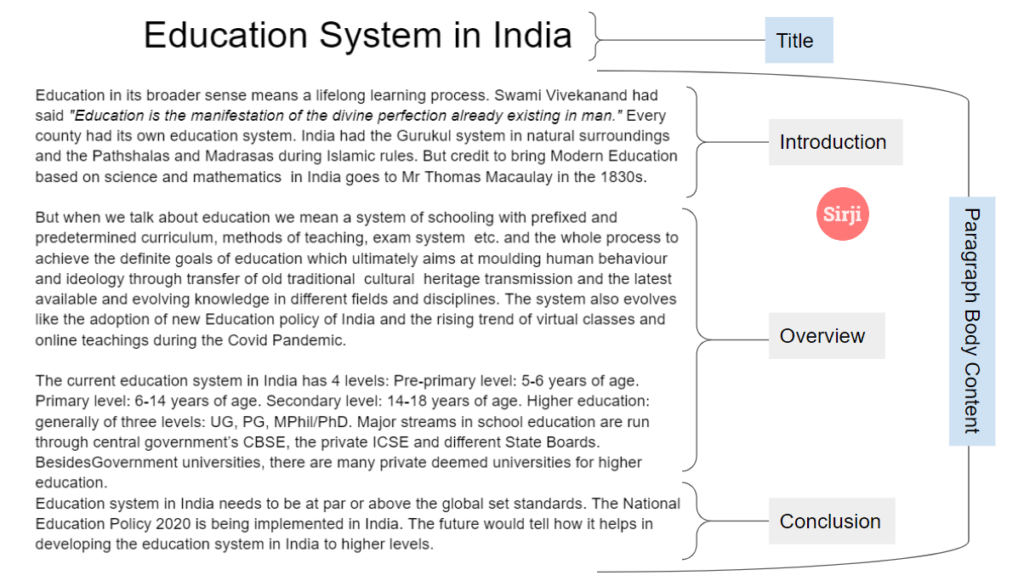What is Analytical Paragraph Writing: Analytical paragraph Is a form of descriptive writing. The writing is analytical in the sense it is based on the input and evidence provided in the question in the form of map, graph, table, cues or chart. There may be a comparison of two or more things or to show choices and preferences also. The data, given in the form of pie charts, line-graphs, bar graphs, maps etc. may be shown as interpreted to show how the things or the trend is different or has become different over the time.
The focus and aim of such a question is to judge the analytical capability and competency of students in creating a writeup in the form of a paragraph sticking to the analytical data or input given in the question.
CBSE Syllabus (2022-23) Class X: Writing an Analytical Paragraph (100-120 words) on a given Map / Chart / Graph / Cues. One out of two questions is to be answered. (5 marks)
Marking Scheme
Objective: Analysis and Evaluation Marks: 1 × 5 = 5
Marks: 1 × 5 = 5 – Breakup of marks:
- Content (3 marks) i.e. body of the paragraph
- 0.5 mark: Title of the paragraph
- 2 marks: Introduction + Overview
- 0.5 mark: Concluding line
- Expression (2 marks) i.e. usage of words and phrases, spellings, correct grammatical structures etc.
- 1 mark: Structure of the paragraph
- 1 mark: Language use
Types of Analytical Paragraphs
- Data / Graph based
- Excerpt / Cue based
Format of the Paragraph
- Title (Heading) – should be proper and relevant
- Introduction – short and precise to tell how you are going to proceed ahead
- Body (an overview) – preferably single paragraph containing a few arguments (in favour or against)
- Conclusion – it should summarise the arguments incorporated in the body of the paragraph
- Note: The whole matter can be written in a single paragraph and it won’t affect marks.
Example

Points to Remember
- It is very important for such paragraphs to use the appropriate vocabulary (usage) which is also called ‘functional language’. For e.g., the terms like increase, decrease, plateau, peak and stable, trend etc. should be used accurately in the passage to fetch you marks under expression.
- Don’t use First person Pronouns (I, we, me, us) and not add your own information or data.
- Your analysis should support the given figure or data. Analyse, compare (if needed) data as if you have to prepare a report. Pick relevant points, features to summarise them into an analytical paragraph.
- Avoid repetitions, use superfluous words, spelling mistakes and try to keep it well punctuated.
- Don’t lose relevance! It is very important to stay on topic and not digress (deviate from the main point and subject).
- The word limit is 100-120 words so it is necessary that you are able to convey all the required information briefly.
- Don’t write under the word count and could go a bit over it between 150-180 words.
Note: Inclusion of a single paragraph organisation with a suitable topic sentence supporting sentences and a suitable concluding sentence. No requirement of a title (because the purpose is analysis, not publication). No penalty if title is written.
Click here for Practice Questions on Analytical Paragraph Writing
Marking Scheme (2022-23 Session)
ANALYTICAL PARAGRAPH WRITING
Marking: Content -2 Organisation of ideas -2 Accuracy 1
NOTE FOR GIVEN DESCRIPTORS—Dedicated marks at a level are to be awarded only if ALL descriptors match. If one or more descriptors do not match, the marks are awarded at a level lower.
CONTENT – 2 marks
2 marks
- All points included
- Well-developed with sustained clarity
1½ marks
- Almost all points incorporated
- Reasonably well-developed
1 mark
- Some points incorporated
- Fair attempt at developing ideas with some impact on clarity of response
½ mark
- Most of the points of the given task not incorporated
- Limited awareness of task development
ORGANISATION OF IDEAS -2 marks
2 marks
- Highly effective style capable of conveying the ideas convincingly
- Carefully structured content with an organised single paragraph, presented cohesively.
- Highly effective register (formal tone and vocabulary), relevant and appropriate sentences for conveying the ideas precisely and effectively.
1 ½ marks
- Frequent clarity of expression most of the time.
- Ideas generally well sequenced and related to the given topic maintaining overall cohesion of ideas.
- Range of vocabulary is mostly relevant and conveys the overall meaning and purpose of the writing.
1 mark
- Inconsistent style, expression sometimes awkward.
- Sequencing of ideas is somewhat clear and related to the given topic attempting to maintain a general overall cohesion.
- Range of vocabulary is limited but manages to convey the overall meaning and purpose of the writing.
½ mark
- Expression unclear.
- Poor sequencing of ideas but ideas related to the given topic in
- a disjointed manner exhibiting a lack of coherence of ideas.
- Very Limited Vocabulary Or Copying From The Question.
ACCURACY-1 mark
1 mark
Spelling, punctuation and grammar consistently/largely accurate, with occasional minor errors, that do not impede communication.
½ mark
Spelling, punctuation and grammar display some errors spread across, causing minor
impediments to the message communicated.
No credit
Frequent errors in spelling, punctuation and grammar, impeding communication.
CBSE Official Page

Click here for Practice Questions on Analytical Paragraph Writing


